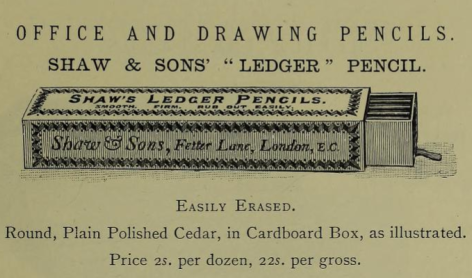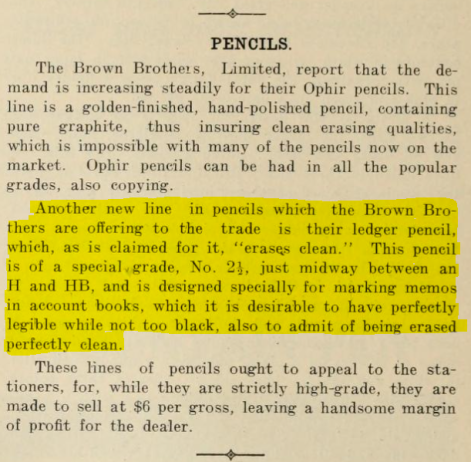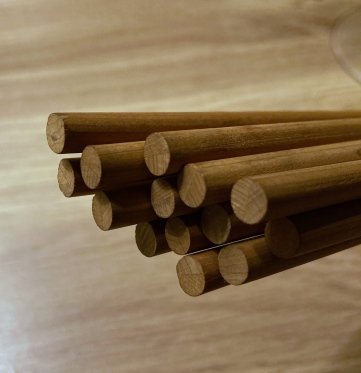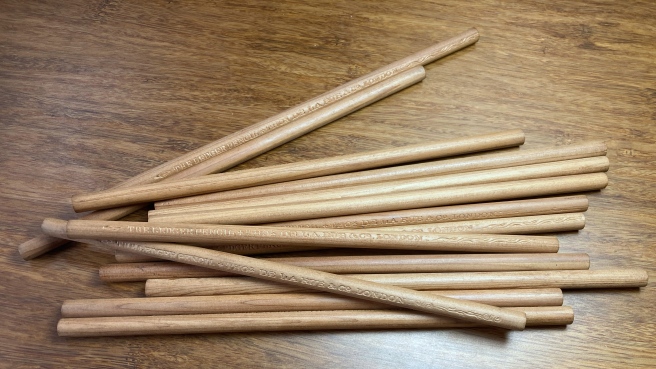Most people will be familiar with De La Rue, usually though: (i) playing cards; (ii) printing money; or (iii) Onoto pens. As you could probably guess, I’m going to focus on their woodcased pencils and on this occasion the ‘ledger pencil’.
Whilst I couldn’t find a direct reference to the ledger pencils, they are very similar in composition to other models manufactured between 1855-1870, therefore I would be pretty confident that the examples in my collection date from around this period.
 I have three variations of the ledger pencil in my collection, as displayed in the picture below. You could be forgiven if you thought that they were the same just with the centering of the stamping being a bit haphazard, however, if you look closely there are subtle differences, the most obvious being the differences in filigree patterns at the ends.
I have three variations of the ledger pencil in my collection, as displayed in the picture below. You could be forgiven if you thought that they were the same just with the centering of the stamping being a bit haphazard, however, if you look closely there are subtle differences, the most obvious being the differences in filigree patterns at the ends. A ledger pencil on this occasion is not too dissimilar to the Wolff’s Bank of England pencil, in that it had a custom core with a specific purpose in mind. The use of a custom core in pencil making history is normally referred to as an ‘off grade’.
A ledger pencil on this occasion is not too dissimilar to the Wolff’s Bank of England pencil, in that it had a custom core with a specific purpose in mind. The use of a custom core in pencil making history is normally referred to as an ‘off grade’.
Of course, with ‘off grades’, you therefore wont see a grade of any kind at the end of the barrel.
 This advert from the Art Journal of 1859 is about as early an example as I could find for De La Rue woodcased pencils:
This advert from the Art Journal of 1859 is about as early an example as I could find for De La Rue woodcased pencils:
 I think its pretty obvious from the name what the ledger pencil was designed for, however, advertising I could find for other examples (such as the Shaw & Sons example below) all spelled out the properties that make a ledger pencil stand out, namely, good point retention and erases cleanly.
I think its pretty obvious from the name what the ledger pencil was designed for, however, advertising I could find for other examples (such as the Shaw & Sons example below) all spelled out the properties that make a ledger pencil stand out, namely, good point retention and erases cleanly.
 I did come across the below advert from Brown Brothers for their version of a ledger pencil which gives us a good explanation. They actually elected to use the 2.5 grade on theirs so we know it was roughly an F grade (in the modern sense).
I did come across the below advert from Brown Brothers for their version of a ledger pencil which gives us a good explanation. They actually elected to use the 2.5 grade on theirs so we know it was roughly an F grade (in the modern sense).
This Brown Brothers advert is quite a bit more modern that the De La Rue examples, being from 1906.
 Johann Faber also made a more modern version of the ledger pencil for the American market, however, it seems they didn’t quite get the memo and released it in multiple grades, totally defeating the point of having a specific grade for purpose:
Johann Faber also made a more modern version of the ledger pencil for the American market, however, it seems they didn’t quite get the memo and released it in multiple grades, totally defeating the point of having a specific grade for purpose:
 As you can see on the De La Rue’s there is no grade present on the pencil barrel:
As you can see on the De La Rue’s there is no grade present on the pencil barrel:
 Any pencils bearing the ‘Thomas De La Rue & Co’ stamping were manufactured before formation of the limited company in 1896.
Any pencils bearing the ‘Thomas De La Rue & Co’ stamping were manufactured before formation of the limited company in 1896.
 As we can see from the notice in the Gazette, the Ltd company was incorporated, dissolved and then incorporated again (as part of a restructure).
As we can see from the notice in the Gazette, the Ltd company was incorporated, dissolved and then incorporated again (as part of a restructure).
 Pencils manufactured after this point have the limited company’s name stamped on them, such as the triangular examples below:
Pencils manufactured after this point have the limited company’s name stamped on them, such as the triangular examples below:
 I don’t believe that De La Rue were making these pencils themselves; like most London makers of this time period, they had one of a number of larger makers produce the pencils and simply include their stamping.
I don’t believe that De La Rue were making these pencils themselves; like most London makers of this time period, they had one of a number of larger makers produce the pencils and simply include their stamping.
So which maker?
The advert below from the 1861 edition of the Guide to Belfast, shows us that De La Rue, like most, were using compressed Cumberland lead. This means the actual maker was either from the Brockedon / Brookman & Langdon camp, or Wolff.
 On this occasion, I’m tempted to go with Wolff for a number of reasons. Firstly, the Wolff advert below from 1854 makes reference to their pencils being ‘perfectly free from git’ and similar language is used in the De La Rue advert above.
On this occasion, I’m tempted to go with Wolff for a number of reasons. Firstly, the Wolff advert below from 1854 makes reference to their pencils being ‘perfectly free from git’ and similar language is used in the De La Rue advert above.
 Secondly, the De La Rue pencils have finished ends; this is something I have come across in other early Wolff examples:
Secondly, the De La Rue pencils have finished ends; this is something I have come across in other early Wolff examples:
 Finally, when I compare the De La Rue to an old Wolff of a similar period (note the rare ‘Inventors London’ stamping), you can see that both the Wolff and the De La Rue have a similar spacing stamp, a sort of round cross. I don’t recall seeing this stamp on any other maker.
Finally, when I compare the De La Rue to an old Wolff of a similar period (note the rare ‘Inventors London’ stamping), you can see that both the Wolff and the De La Rue have a similar spacing stamp, a sort of round cross. I don’t recall seeing this stamp on any other maker.

The Wolff example in the picture above is actually thicker than a standard round pencil, but the De La Rue is also ever so slightly thinner than normal. Not bridge pencil skinny but just a tiny bit.
I’m glad they finally got round to designing hex pencils, these were a nightmare to photograph, they kept rolling off the table!
An uncommon pencil for sure, if you have other early De La Rue examples, I’d love to hear from you.
